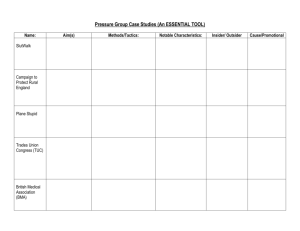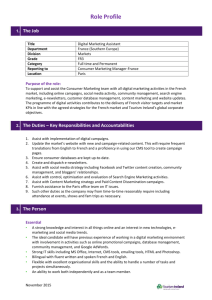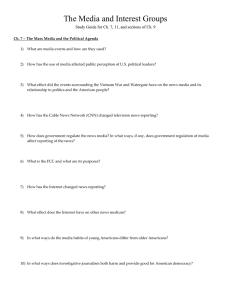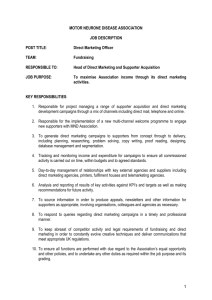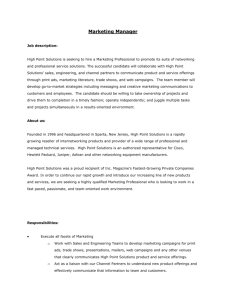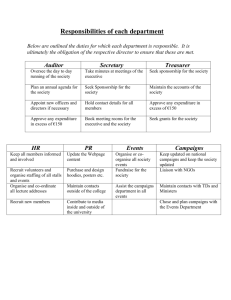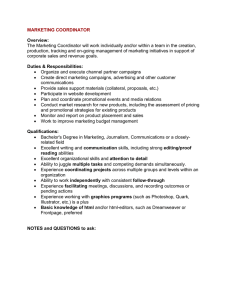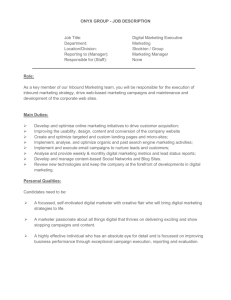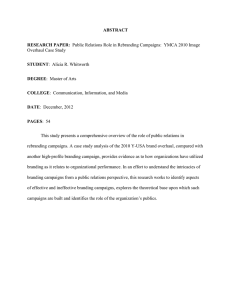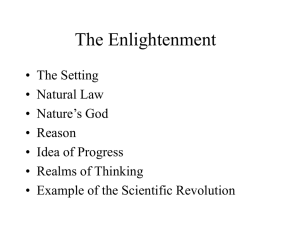Report Effectiveness of Campaigns on Carbon Monoxide
advertisement
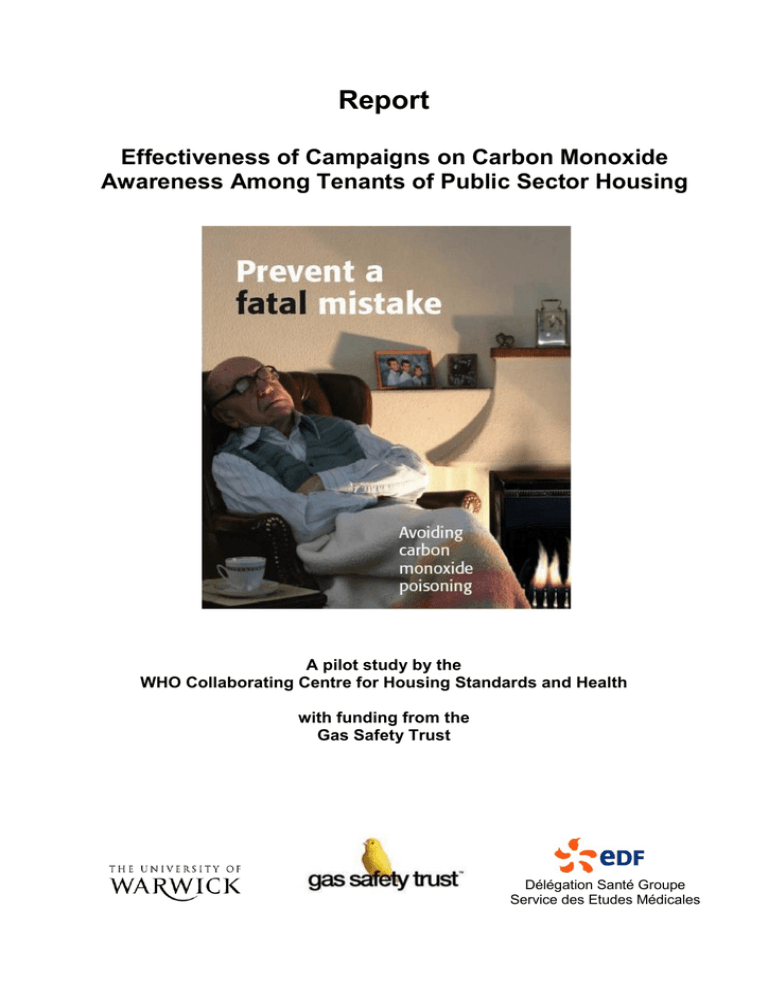
Report Effectiveness of Campaigns on Carbon Monoxide Awareness Among Tenants of Public Sector Housing A pilot study by the WHO Collaborating Centre for Housing Standards and Health with funding from the Gas Safety Trust Délégation Santé Groupe Service des Etudes Médicales Report – Tenant CO Survey December 2011 2 Report – Tenant CO Survey December 2011 ACKNOWLEDGEMENTS We are grateful for the support and assistance of those who made this project possible, in particular – The Gas Safety Trust for supporting the study Dave Crossan for the co-ordination, the interviews, and the seminar Rob Nolan for help with the seminar From Warwick University ~ Julie Cook, for administration Susan Goodlad, for arranging the data entry and validation Jas Bains, for help with the seminar Service des Etudes Médicales d‟EDF Pierre-André Cabanes Elisabeth Pigeon We are also grateful to all those who agreed to take part in the survey. Véronique Ezratty, David Ormandy, and Serge Koscielny Warwick, December 2011 3 Report – Tenant CO Survey December 2011 4 Report – Tenant CO Survey December 2011 PILOT STUDY OF EFFECTIVENESS OF CAMPAIGNS ON CO AWARENESS AMONG TENANTS OF PUBLIC SECTOR HOUSING CONTENTS Page ACKNOWLEDGEMENTS 3 EXECUTIVE SUMMARY 7 INTRODUCTION 9 - Objectives 10 METHOD 11 - Questionnaires 11 - Interview Protocol 12 - Statistical Analyses 12 RESULTS 13 - Participants 14 - Campaigns, Information and Press Reports 14 MAIN FINDINGS 15 - Knowledge before Campaigns 15 - Effectiveness of Campaigns in Increasing Knowledge 16 - Effectiveness of Campaigns in Influencing Behaviour 18 DISCUSSION 18 - General Background 18 - Study Design 19 - The Results 20 CONCLUSION AND PERSPECTIVES - 21 Messages/Recommendations 21 REFERENCES 21 ANNEXES 23 1- Examples of Information, Campaigns and Media on CO and Gas Safety 25 2- Some CO interested National Organisations and Bodies 29 3- Phase 2 Questionnaire 33 5 Report – Tenant CO Survey December 2011 TABLES Page TABLE 1 – THE CO RELEVANT QUESTIONS 13 TABLE 2 – SOME CHARACTERISTICS OF PARTICIPANTS IN EACH PHASE 14 TABLE 3 – YEARS IN CURRENT ACCOMMODATION 14 TABLE 4 – CORRECT RESPONSES TO SOME GENERAL SAFETY QUESTIONS 15 TABLE 5 – CORRECT RESPONSES TO CO SPECIFIC QUESTIONS 15 TABLE 6 – COMPARISON OF RESPONSES TO SOME OF THE CO RELEVANT QUESTIONS 17 6 Report – Tenant CO Survey December 2011 PILOT STUDY OF EFFECTIVENESS OF CAMPAIGNS ON CO AWARENESS AMONG TENANTS OF PUBLIC SECTOR HOUSING EXECUTIVE SUMMARY Recognising that unintentional Carbon Monoxide (CO) poisoning at home is a serious public health problem, there are annual campaigns in the UK between October and April. These campaigns aim to raise awareness about CO and to influence behaviour. While there have been studies into the effectiveness of mass media campaigns on other health related topics, it appears that there has been little, if any, assessment of the effectiveness of campaigns on CO awareness. Tenants of public sector housing are considered a population potentially vulnerable to the risks from CO poisoning, and the main objectives of this study were to investigate – 1. The knowledge about CO in this population before any campaigns, and so assess the need for campaigns. 2. How effective campaigns were in increasing their knowledge about CO, awareness of the dangers of CO, and in influencing their behaviour. This pilot study targeted public sector tenants in the city of Coventry, UK. A trained interviewer carried out two sets of structured interviews in controlled conditions, first in October 2009 (Phase 1), and then at the end of the heating season in April/May 2010 (Phase 2). The same format and content was used for the interviews in both Phases. To try to avoid involvement in the study raising awareness of CO, it was designed to appear as if it was about the indoor environment generally, with questions on CO mixed with questions on other pollutants so „blinding‟ the participants to the main purpose. Campaigns on CO awareness and gas safety were monitored between October 2009 and May 2010. This included gathering information on national and local campaigns, and monitoring press coverage of any CO incidents. To assess knowledge of CO and its dangers, participants were asked both general safety questions that were directly or indirectly relating to CO, and CO specific questions. These were combined as the „CO relevant questions‟. In Phase 1 (N=117), the mean proportion of correct answers to „CO relevant questions‟ was 49%, but only 9% knew the unsafe colour of a gas flame and 40% did not know the telephone number for the emergency services. In Phase 2 (N=144), the mean proportion of correct answers to „CO relevant questions‟ remained the same at 49%, and the percentage knowing the dangerous colour of a gas flame remain low, rising from 9% to just 10%. The percentage knowing the telephone number for the emergency services dropped slightly from 60% to 53%. Of the 49 (34%) in Phase 2 who said that they recalled CO campaigns, it was television that was most remembered. And of these, 21 (43% of the 49) said that they had now changed their behaviour. Before the campaigns, the level of knowledge in this population was found to be average, supporting the view that campaigns targeted at this population are needed. In Phase 2, the level of knowledge to the „CO relevant questions‟ had not increased. This means that the impact of campaigns on the knowledge, awareness, and behaviour of this population could be improved and better targeted, recognising in particular any possible language or cultural barriers. 7 Report – Tenant CO Survey December 2011 Messages from this Study among Public Sector Tenants CO awareness campaigns are necessary. Campaigns need to be targeted to this population, and their effectiveness should be monitored. It should be recognised that television appears to be the most remembered media. Tenants should be given clear safety instructions and information on the risks from CO. Tenants need to be made aware of the telephone number for emergency services. There should be co-ordination between Housing Associations and the large number of bodies with responsibilities for the prevention of CO poisonings. CO detectors should be fitted in all public sector dwellings and tenants made aware of them. 8 Report – Tenant CO Survey December 2011 PILOT STUDY OF EFFECTIVENESS OF CAMPAIGNS ON CO AWARENESS AMONG TENANTS OF PUBLIC SECTOR HOUSING INTRODUCTION Unintentional Carbon Monoxide (CO) poisoning in dwellings is a serious public health problem. Countries may have information on the number of fatalities attributable to CO poisoning, but because of the possibility of misdiagnosis of non-fatal cases, the total burden from CO poisoning is uncertain. This is the case in the UK where the scale of the problem is unclear as different agencies collect data from different sources and by different methods. For example, in the year 2009/10, the Downstream Incident Data Report (DIDR, 2010) gives the numbers of deaths from CO poisoning as 7 and of injuries as 117 for England and Wales, while the National Health Service reports that there were more than 50 deaths and over 200 injuries (http://www.nhs.uk/Conditions/Carbon-monoxide-poisoning/Pages/Introduction.aspx ). The main potential source of CO within dwellings is from the incomplete combustion of carbon based fuels, including gas, oil, and solid fuels. This incomplete combustion may be caused when an appliance is malfunctioning or misused, or where there is inappropriate ventilation. The acute health effects of CO are well documented (see Kao and Nanages, 2006; and Cho et al, 2008). At high concentrations, inhalation of CO can cause unconsciousness and death. At lower concentrations, inhalation can cause a range of symptoms from headaches, dizziness, weakness, nausea, confusion, and disorientation, to fatigue; all symptoms easily confused with those caused by illnesses such as influenza, and with depression. Recognising the potential dangers from CO, most European countries have adopted the guidelines and standards on CO recommended by the World Health Organization (WHO 1999, and 2010) and the Expert Panel on Air Quality Standards (EPAQS, 1998). Groups of the population are often considered to be vulnerable to exposure to unsafe levels of CO for various reasons. One such group are tenants of public sector housing. The demographics of this group show that, compared to other tenure groups, there are higher proportions of people over 64, out of employment, from ethnic minorities, and lone parents (CLG, 2011). This suggests that they may be more vulnerable than other groups as they may – - have low available finances and so struggle to meet energy costs, and, in particular, they may reduce ventilation and use unsuitable heating appliances - spend above average time in their home - not have English as their Mother-tongue Every year in the UK there are public awareness campaigns running from autumn to the end of the heating season, some aimed at the public generally, and others targeting potentially vulnerable groups. However, it appears that there has been little if any assessment of the effectiveness of such campaigns. This pilot study was carried out among tenants of public sector housing (managed by Housing Associations) in the city of Coventry (UK) to investigate the need for, and the effectiveness of, campaigns on knowledge and behaviour relating to the risks from CO. 9 Report – Tenant CO Survey December 2011 OBJECTIVES The main objectives of this study were to – 1. Assess the level of knowledge on CO in a population of public sector housing before any campaigns (ie, in October 2009) 2. Assess whether, at the end of the heating season in April 2010, the campaigns had – a. increased significantly knowledge on CO b. raised awareness of the dangers of CO, and c. influenced behaviour To meet these objectives and to be able to interpret the results, three end-points were devised. These were – 1) First End-Point – Assessment of Knowledge in a Population of Public Sector Housing Tenants before the Campaigns In October 2009, the level of knowledge of the tenants before the campaigns was assessed (Phase 1). We considered that the need for campaigns would be questionable if the level of knowledge in this population was high before the campaigns are released (ie, > 70% of good responses to „CO relevant questions‟ – see Table 1). 2) Second End-Point – The Effectiveness of the Campaigns in Increasing Knowledge on CO In April/May 2010 at the end of the heating season and after the campaigns, the knowledge was reassessed (Phase 2). We considered that the increase in the level of knowledge would be high enough if – a) it had increased by at least 20% absolute and b) there were more than 80% good responses to the „CO relevant questions‟. 3) Third End-Point – The Effectiveness of the Campaigns in Influencing Behaviour Also in Phase 2, tenants were asked if they remembered campaigns, and if so, which were the media most remembered. Those who remembered campaigns were then asked whether they had changed their behaviour and, if so, how. 10 Report – Tenant CO Survey December 2011 METHOD The participants for the study were tenants of public sector housing in the city of Coventry, recruited through local associations and residents‟ groups. Two sets of structured interviews were carried out in controlled conditions, the first in October 2009 (Phase 1), and the second at the end of the heating season in April/May 2010 (Phase 2). To try to avoid involvement in the study raising awareness about CO awareness the survey was designed to appear as if it was about the indoor environment generally, and interviewees were „blinded‟ by being told that this was the main purpose of the survey. Between the interviews for Phase 1 and those for Phase 2, campaigns on CO awareness and gas safety were monitored. This included obtaining details of any national and local campaigns and monitoring press coverage of CO incidents. To assess whether being involved in Phase 1 influenced knowledge and/or awareness, new tenants were recruited for Phase 2, and their responses compared with those who had taken part in both Phase 1 and 2. The study was approved by the University of Warwick Ethics Committee. QUESTIONNAIRES To provide a basis for the structured interviews, questionnaires were devised (see Annex 3). To maintain the impression that the interview was about the indoor environment, questions relevant to knowledge and awareness of carbon monoxide were mixed in with other questions, including questions on general safety and other possible indoor pollutants. Drafts of the Phase 1 questionnaire were tested by volunteers who would not be involved in the study. These tests helped to ensure that, as far as possible, the questions were clear and unambiguous, and, importantly, that the overall impression given was that the study was about the indoor environment. The questionnaire was divided into five sections. The cover page, as well as the date of the interview, collected personal details of the participant, including name, address, contact details, etc. A unique code was given for each respondent, and the cover page was to be removed before data-entry to anonymise the results (a requirement of the University Ethics Committee). These personal details were used only to allow for matching of the interviewee code, enabling the responses for those who took part in both Phase 1 and Phase 2 of the study to be compared. The first part of the questionnaire dealt with the individual and the household, with questions about the characteristics of the household, smoking habits, nationality, and occupation (if any). The second part covered some basic information about the nature of the accommodation, including whether it was self-contained house or apartment in a purpose-built block. 11 Report – Tenant CO Survey December 2011 The third part focused in more detail on the accommodation and the use made of it. Included in this part were some questions on general safety as well as ones specific to CO. As well as the time spent in the accommodation, there were questions on the form of space and water heating, the type of cooking facilities, whether a smoke detector, CO detector, or burglar alarm were fitted, and the means of ventilation in particular rooms. There were also questions on who was responsible for maintenance of the heating and cooking appliances, what action should be taken if there was a problem with the indoor air quality, and what was the telephone number for the emergency services. Part three then went on with specific questions on some possible indoor pollutants – Dampness and Mould; Oxides of Nitrogen; Carbon Monoxide; and Formaldehyde. The questions for all of these were identical, starting with whether it could be found in dwellings. Where the interviewee thought it could be found in dwellings, further questions were asked, including whether the pollutant could affect health, and if so, the severity of that effect. There were then multiple choice questions on the type of health effects (including some that could not be caused by any of these pollutants), the possible sources, and where the respondent had learnt about that pollutant. The fourth part of the Phase 1 questionnaire simply asked whether the interviewee would be prepared to take part in Phase 2 around April/May of 2010. The Phase 2 questionnaire was identical, except for Part 4. This started by asking whether the interviewee recalled any CO awareness campaigns, and if so, what media was remembered. Where they remembered the campaigns, they were also asked whether they had changed their behaviour, and if so, how. INTERVIEW PROTOCOL All the interviews were conducted by the same person who had been and was working with tenants‟ associations and residents‟ bodies in the area. A briefing session for the interviewer was arranged one week before the start of the study. The briefing explained that the interviewer was to use the questionnaire as the basis of a structured interview, recording the answers given by the respondents on the questionnaire. The interviewer was also instructed not to help or suggest answers, although where necessary pictures of appliances (eg, hobs, ovens etc) could be shown. Importantly, the interview was to be introduced by explaining that the aim was to gather information on the indoor environment of the accommodation. A similar briefing session was arranged for one week before Phase 2 of the study, in April 2010. The interviewer was reminded that he must not prompt the respondents, and again it was stressed that the respondents were to be informed that the interview was about the indoor environment generally. However, as there were additional questions on CO Awareness Campaigns in Phase 2, the interviewer was instructed to read out the following statement at the end of the interview – „This survey aims to assess what people know about indoor air quality, and, for it to be effective, it is important that you do not discuss what is covered with anyone who has not yet taken part.‟ STATISTICAL ANALYSES Although the interviews covered several pollutants and some information on general safety and the indoor environment, only the „CO relevant questions‟ (see Table 1) were analysed. The „CO relevant questions‟ were both general safety questions 12 Report – Tenant CO Survey December 2011 directly or indirectly relating to CO (see Table 1(a)) and CO specific questions (see Table 1(b)). For each question, the proportion of correct answers was estimated. In the case of multiple choice questions, only when right answers were given and no other, was the answer considered correct. Where „don‟t know‟ was an option it was considered to be a wrong answer. For each question the proportions of correct answers to Phase 1 and Phase 2 were compared using a Chi-Square test, and P-values less than 0.05 were considered to be statistically significant. 3.7 Would any of these be a sign of a problem with a gas appliance? Blue flame Green flame Orange flame Don‟t know 3.9.3 If you had a problem with any heating and/or cooking appliance – Who would you contact? (tick one only) Landlord/Agent A heating/gas engineer Local authority Parents Don‟t know Other Specify _______________________________________ 3.9.4 3.9.7 Is there a problem with your cooking or heating appliances? Yes No Don‟t know If you suspected there was an immediate problem with the indoor air quality, what would you do? (tick all that apply) Call the Landlord/Agent Open windows Turn off the cooking/heating appliances Call an emergency number Go outside until you are told it is safe to return Call your parents/a friend Call the local authority Other Specify ____________________________________________ Don‟t know Do you know the telephone number for the landlord? Yes No 3.9.8 Do you know the emergency telephone number? Yes 3.9.9 If “yes” to 3.9.8, specify which is correct (tick all that apply) 999 0800 111 999 112 911 Is there a carbon monoxide detector fitted? Yes No Don‟t know 3.9.6 3.12 No Table 1(a) – General Safety Questions Directly or Indirectly relating to CO in the Questionnaires 3.17 3.17.1 3.17.2 3.17.3 3.17.3.1 3.17.3.2 3.17.3.3 Can Carbon Monoxide be found in dwellings? Yes No Don‟t know Does it have a smell? Yes No Don‟t know Can you see it? Yes No Don‟t know Can it affect your health? Yes No Don‟t know If “yes” to 3.17.3 using a scale of 1 to 5 (1 for mild and 5 for fatal) how serious can the health effects be ? If “yes” to 3.17.3 what are the health effects? (tick all that apply) Breathing difficulties Chest pains Eye irritation Tiredness Dizziness Ear ache Nausea/vomiting Rash Don‟t know What are the possible sources? (tick all that apply) Pollution from outside (eg. Traffic) Carpets and furnishings Combustion (eg. Cooking, heating appliances Don‟t know Table 1(b) – CO Specific Questions in the Questionnaires Table 1 – The CO Relevant Questions 13 Headaches Report – Tenant CO Survey December 2011 RESULTS PARTICIPANTS There were 117 participants interviewed in Phase 1, of which 73% gave their nationality as British. In Phase 2, a total of 144 participants were interviewed, 57 of whom had taken part in Phase 1, and further 87 were new participants. Of the Phase 2 participants, 77% gave their nationality as British. Phase 1 (N=117) Phase 2 (N=144) Male 52% 49% Female 48% 51% 3% 7% 20-45 47% 44% 45-60 22% 24% Over 60 28% 26% Under 20 Missing data excluded Table 2 – Some Characteristics of Participants in each Phase The majority of participants had been living in their accommodation for more than five years – 69 (60%) of those in Phase 1 and 84 (59%) of those in Phase 2. Number of Years Phase 1 (N=113) Phase 2 (N=142) 1-5 45 (39%) 58 (41%) 6-10 27 (24%) 32 (23%) 11-15 15 (13%) 21 (15%) 16-20 13 (11%) 12 (8%) 20+ 14 (12%) 19 (13%) Missing data excluded Table 3 – Years in Current Accommodation INFORMATION, CAMPAIGNS AND PRESS REPORTS Information relating to CO and gas safety was collected, and the media (including newspapers and the internet) were monitored. The information identified included – A Tenant‟s Handbook, which is given to each tenant at the start of a Housing Association tenancy. This contains a copy of the tenancy agreement and documents giving information about who to contact about repairs and in an 14 Report – Tenant CO Survey December 2011 emergency, with the telephone numbers. The Handbook also set out the responsibilities of the tenant and of the landlord, including who is responsible for maintenance of heating appliances (in the UK this is the landlord). Campaigns aimed at the public generally during the 2009/10 heating season, run by various bodies and agencies, including CO-Awareness, the Health and Safety Executive, and the Health Protection Agency.. Press reports on incidents of CO poisoning, and at least one information piece on a day-time television programme. A range of the campaigns and press coverage is summarised in Annex 1. MAIN FINDINGS 1) First End-Point – Assessment of Knowledge in this Population before the Campaign(s) The mean proportion of correct answers to the „CO relevant questions‟ in Phase 1 (N=117) was 49%. Table 4 shows the mean percentage of correct responses to some of the general safety questions directly or indirectly relating to CO and Table 5 shows the mean percentage of correct responses to CO specific questions. Questions Mean Percentage Knowledge of possible problems with a cooking or heating appliance 93% Correct actions to take if a problem with indoor air quality was suspected 80% Knowing if there is a CO detector fitted 76% Saying that they knew the telephone number for the landlord 67% Saying that they knew the telephone number for emergency services 60% Table 4 –Correct responses to Some General Safety Questions Directly or Indirectly relating to CO Questions Mean Percentage Knowing that CO can affect health 56% Knowing that CO cannot be seen 54% Knowing that Carbon Monoxide can be found in dwellings 53% Knowing CO does not have a smell 44% Knowing the dangerous colour of a gas flame 9% Table 5 – Correct responses to CO Specific Questions In Phase 1 (N=117), the percentage knowing that CO could be fatal was 43%, and the percentage knowing possible sources of CO was 50%. 15 Report – Tenant CO Survey December 2011 2) Second End-Point – The Effectiveness of the Campaigns in Increasing Knowledge on CO In Phase 2, the responses from those re-interviewed (N=57) and from the new interviewees (N=87) were not significantly different. Therefore, we combined the responses from the two groups. The mean proportion of correct answers to the „CO relevant questions‟ remained the same to that in Phase 1 – 49% (N=144) in Phase 2 and 49% (N=117) in Phase 1. The percentage stating that CO could be found in dwellings dropped to 45% in Phase 2 from 53% in Phase 1. There was also a decrease in the percentage who said that CO could affect health, to 46% from 56%, and in those who thought it could be fatal, to 35% from 43%. In neither case was this significant. The responses for the „CO relevant questions‟ for both kinds of participants in Phase 2 according to their participation or not to Phase 1, are reported in Table 6 with p values for each comparison – Those interviewed in Phase 1 (N=117) with those interviewed in Phase 2 (N=144). Those interviewed in both Phases (N=57) with those interviewed only in Phase 2 (N=87). The responses from Phase 1 with the responses from Phase 2 of those interviewed in both Phases (N=57). 16 Responses in Phases 1 vs responses in Phase 2 P value Responses in Phase 2 of those interviewed in both Phases vs those who only took part in Phase 2 Responses of those who took part in both Phases Phase 1 and 2 (N=57) Phase 2 only (N=87) Phase 1 (N=57) Phase 2 (N=57) Phase 1 (N=117) Phase 2 (N=144) P value P value Is there a problem with your cooking or heating appliances? 93% 100% 0.001 100% 100% 1.00 95% 100% 0.08 Is there a CO detector fitted? 76% 79% 0.55 82% 77% 0.43 79% 82% 0.64 What action would you take if you suspect a problem with the indoor air quality? 80% 94% 0.001 93% 94% 0.76 75% 93% 0.01 Do you know the telephone number for the landlord? 67% 75% 0.14 82% 70% 0.10 61% 82% 0.01 Do you know the telephone number for the emergency services? 60% 53% 0.25 54% 52% 0.76 53% 54% 0.85 Can CO affect your health? 56% 46% 0.11 54% 40% 0.10 63% 54% 0.34 Can CO be found in dwellings? 53% 45% 0.21 53% 40% 0.15 61% 53% 0.34 Does CO have a smell? 44% 38% 0.38 40% 37% 0.67 40% 40% 1.00 Can you see CO? 54% 47% 0.29 54% 43% 0.16 58% 54% 0.71 9% 10% 0.93 11% 9% 0.79 4% 11% 0.14 Can CO be fatal? 43% 35% 0.23 39% 33% 0.52 54% 39% 0.09 Knowing possible sources of CO 50% 40% 0.13 44% 38% 0.48 58% 44% 0.14 Overall mean correct responses to the CO relevant questions 49% 49% 0.83 53% 47% 0.21 52% 53% 0.55 General Safety Questions Directly or Indirectly relevant to CO CO Specific Questions What is the dangerous colour of a CO flame? Table 6 – Comparison of Responses to some „CO relevant questions‟ Report – Tenant CO Survey December 2011 3) Third End-Point – The Effectiveness of the Campaigns in Influencing Behaviour In Phase 2, 49 (34% of the 144) said that they remembered CO campaigns; and of these, 11 (22% of the 49) said that they remembered the latest campaigns. Asked what media they remembered, 47 (96%) said it was television, 21 (43%) said newspapers, and 7 (14%) said the internet (more than one response could be given). Of the 49 respondents who remembered the CO campaigns, 21 (43%) said that they had changed their behaviour. When asked how, 3 said that they would have their appliances checked, and 2 that they had got a detector. Another 12 said that they had become more aware, including that they intended to get a detector, and that they realised the dangers of CO. DISCUSSION GENERAL BACKGROUND The main purpose of any public health awareness campaign is to raise understanding and influence behaviour. Knowledge of the dangers, of the precautions, and of the appropriate action to take in the event of an emergency is important, not just for CO, but also for other emergencies (such as fire and medical crises). However, while there have been studies into the effectiveness of mass media campaigns on other health related topics, it appears that there have not been any published studies assessing the effectiveness of campaigns on CO awareness. Two systematic reviews were recently published, one focusing on communication about environmental health risks (Fitzpatrick-Lewis et al, 2010), the other on the effectiveness of mass media campaigns to influence healthy behaviour (Wakefield et al, 2010). The risks covered by the first review included radon, chemical spills, natural disasters, bioterrorism and infectious diseases. The second review looked at three types of campaigns – those aimed at actions that put health at risk (such as tobacco, alcohol and drug use, sex-related behaviour) and may be felt to give pleasure (a selfish and perhaps immediate benefit), those to persuade individuals to check if their health is at risk (like screening for cancer, vaccination), and those to encourage action to protect health (such as wearing car seat-belts). These reviews found that the impact or effectiveness of campaigns is affected by personal risk perception, previous personal experience with emergencies, and trust in the source of information. This last point is support by a recent study, which found that health care professionals, as trusted personnel, could have an important role in communication of risks and preventative behaviour, reinforcing the impact of campaigns (Marchwinska-Wyrwal et al, 2011). While finding that primary studies were of poor methodological quality, the first of the reviews concluded that how messages are delivered is important (Fitzpatrick-Lewis et al, 2010). This included the adoption of strategies that recognise the needs of the target audience, incorporating personal inter-action, and the use of various methods of delivery which increase the likelihood of reaching a wider audience. It also recommended that messages should be based on sound research of the target group and be tested throughout the campaign development. 18 Report – Tenant CO Survey December 2011 The other review found that campaigns are likely to be more successful if there are multiple interventions, and that the accessibility of and access to services and products are necessary so that individuals can act on the messages (Wakefield et al, 2010). It also suggested that news and entertainment media covering public health issues represent a promising complementary strategy to campaigns. There are specific considerations to take into account in relation to risks from CO. We believe that campaigns on CO need to address three aspects to be effective – knowledge of the dangers from CO; awareness that everyone could be at risk and that change of behaviour is necessary; and behaviour change. As they personalise the dangers and outcomes, press reports of serious CO incidents may have an important impact. As CO is so insidious – it is a gas that cannot be seen, smelt, tasted or heard – and because exposure can be fatal, a minimum of knowledge about it is necessary. However, knowledge of the risks from CO may not be enough. A telephone survey was carried out in France involving over 6,000 telephone interviews of a random representative sample of people aged between 18 and 75 years (Girard et al, 2008). This survey found that the vast majority, over 75%, knew about CO and that it was a serious problem. However, only 11% thought that CO poisoning could happen to them, and over 77% of those with at least one potential CO source in their home did not consider they were at risk. The findings from this French study support the idea that the important public health messages to be promoted are that the risk of exposure can affect everyone, that the source may be from next door, and that precautionary measures are necessary. Knowing that something should be done, does not mean that it is done. Campaigns should cover advice and information on behaviour, such as simple preventative measures and actions to take in case of possible CO exposure. THE STUDY DESIGN We believe that our study design is original in assessing the effectiveness of campaigns. In designing the protocol, we discounted options such as self-completed paper questionnaires or web-based surveys even though either option may have increased the number of participants. Using interviews in controlled conditions ensured there was no possibility of the participant checking responses with other people or looking-up the answers. By „blinding‟ interviewees to the main purpose of the study, mixing the questions on CO among other questions, and carrying out the interviews in controlled conditions using a trained interviewer we ensured that the responses given were as close to the participants‟ current knowledge on CO as possible. The use of structured interviews, based on a questionnaire, meant that the same information was collected in both Phase 1 and 2, allowing comparison between individuals and between the Phases. The before and after approach was also intended to avoid the possible influence of a single stage follow-up survey that named the campaign or the subject. The reason for recruiting new tenants for Phase 2 was to assess whether being involved in Phase 1 had influenced knowledge. The mean proportion of correct responses from those re-interviewed in Phase 2 (N=57) and the new interviewees in Phase 2 only (N=87) was not significantly different. This absence of difference could be either because of a lack of influence of Phase 1, or because of a lack of statistical 19 Report – Tenant CO Survey December 2011 power to show a difference. Therefore, while we should be cautious of the interpretation of this finding, combining the responses from both groups increased the statistical power of the comparisons. THE RESULTS The level of knowledge about CO in this population before the campaigns (ie, in Phase 1) was average. Because of the design of our study this could be close to reality. However, the participants were volunteers who responded to an invitation to take part in a study on the residential indoor environment, and so they cannot be assumed to be representative of public sector tenants as a whole. These volunteers may have had a greater interest in the topic or their housing than others. Also, it may be that some of those whose Mother-tongue is not English, may have been reluctant to take part in case they did not understand the questions or how to respond clearly; similarly, those who may have been recent immigrants may have had different experiences of their indoor environment and also have been reluctant. The level of knowledge to the „CO relevant questions‟ in Phase 2 compared with Phase 1 remained the same at 49%. And, while 49 (34%) of those taking part in Phase 2 (N=144) said that they remembered campaigns on CO, only 11 (22%) of these said they remembered the latest campaigns, and, more importantly, those campaigns did not appear to have had any significant impact. Of those who recalled the campaigns, television was the media most remembered. That the overall level of knowledge to the „CO relevant questions‟ in Phase 2 had not increased does not necessarily mean that the campaigns had no effect, even though only a low percentage remembered the latest campaigns. Without campaigns, the level of knowledge may have declined, if not over the months of this study, perhaps over a period of a few years. There was a slight decrease in the numbers knowing the correct telephone number for the emergency services (53% from 60%). The low percentage in each Phase is of particular concern as everyone should know the number in case of any emergency, including fire and medical crises. The responses to the question on the dangerous colour of a gas flame remained very low (10% in Phase 2 compared to 9%). This again is of particular concern as most campaigns highlight the gas flame colour, and, as CO cannot be seen or smelt, the flame colour may be one important clue that there is a possible risk of exposure to CO. However, it is of interest to note that this population of tenants were very knowledgeable concerning their cooking and heating appliances and action to take in case of a suspected problem with the indoor air quality in their dwellings. Furthermore, there was a significant increase in between Phase 1 and Phase 2 for those two CO relevant questions. Those suspecting a problem with a cooking or heating appliance rose from 93% to 100% (p=0.001); and those knowing what action to take if they suspected a problem with the indoor air quality rose from 80% to 94% (p=0.001). 20 Report – Tenant CO Survey December 2011 Conclusion and Perspectives The level of knowledge about CO in this group of public sector tenants before the campaigns (ie, in Phase 1) was found to be average. As there was less than 70% of good responses, a level above which we consider the need for campaigns could be questioned, we conclude that campaigns targeted at this population are necessary. As we found that the level of knowledge to the CO specific questions in Phase 2 had not increased, this suggests that the 2009/10 campaigns could have been be more effective. This is supported by the low percentages (43% of the 49 who said they remembered campaigns), and who said they had changed their behaviour (22% of the 49). Further studies with larger numbers are needed to confirm these results. MESSAGES/RECOMMENDATIONS The following recommendations are based on the findings from this study – Campaigns on CO awareness are necessary. Campaigns need to be targeted to reach specific audiences, and it should be monitored to ensure that they are reaching, informing, and influencing the intended audiences, in this case public sector tenants. It should be recognised that television is the most remembered source of information on CO campaigns for this particular population group. Tenants need clear and straight-forward safety instructions about gas, oil and solid fuel appliances and the risks from CO, including advice about what to do in the event of a CO detector raising the alarm, and advice on symptoms that could suggest exposure. Tenants need to be made aware of the telephone number for the emergency services, and in the case of those with impaired hearing, the emergency SMS service – http://www.emergencysms.org.uk/ There are a large number of bodies with responsibilities for, or interests in, preventing CO poisonings. There is a need for co-ordination between the Housing Associations, local authorities, Fire and Rescue Services, the Health and Safety Executive, and local health centres. All public sector accommodation should be fitted with working CO detectors and tenants shown how test them, and how often. Doctors and health care personnel could have an important role in raising CO awareness and in promoting campaigns. REFERENCES Cho CH, Chiu NC, Ho CS, Peng CC. (2008). Carbon monoxide poisoning in children. Pediatr Neonatol. Aug;49(4):121-5. CLG (2011). English Housing Survey: Headline Report 2009-10. Department for Communities and Local Government. London. DIDR (2010). The United Kingdom‟s Official Incident Data Report focusing on carbon monoxide deaths and serious incidents from piped natural gas and liquid petroleum gas (LPG) during 2009/10. Gas Safety Trust, Basingstoke, UK. 21 Report – Tenant CO Survey December 2011 EPAQS (1998) A Recommendation for a United Kingdom Air Quality Standard for Carbon Monoxide. Expert Panel on Air Quality Standards (now the Committee on Medical Effects of Air Pollutants (COMEAP). Fitzpatrick-Lewis D, Yost J, Ciliska D, and Krishnaratne S (2010). Communication about environmental health risks: A systematic review. Environmental Health, 9:67. Girard D, Leon C, Gourier-Frery C (2008). Monoxyde de carbone. In: Menard C, Girard D, Leon C, Beck F. Baromètre santé environnement 2007. Saint Denis: INPES, 2008 : 191-211. Kao LW, Nanagas KA. (2006). Toxicity associated with carbon monoxide. Clin Lab Med. Mar;26(1):99-125. Marchwinska-Wyrwal E, Teaf CM, Dziubanek G, and Hajok I (2011) Risk assessment and risk communication in environmental health in Poland. EJPHA, advanced access, 22-08-2011. Rice RE and Atkin CK (eds) (2001). Public Communication Campaigns. Sage Publications, London. Wakefield MA, Loken B, and Hornik RC (2010). Use of mass media campaigns to change health behaviour. Lancet; 376:1261-71. WHO (1999). Environmental health criteria 213:carbon monoxide (2nd edition). Helsinki: World Health Organization. WHO (2010). Guidelines for indoor air quality: selected pollutants. Copenhagen: World Health Organization. 22 Report – Tenant CO Survey December 2011 ANNEXES TO REPORT PILOT STUDY OF EFFECTIVENESS OF CAMPAIGNS ON CO AWARENESS AMONG TENANTS OF PUBLIC SECTOR HOUSING 23 Report – Tenant CO Survey December 2011 24 Report – Tenant CO Survey December 2011 Annex 1 Examples of Campaigns, Information and Media on CO and Gas Safety, October 2009 to April 2010 A press release was issued on 13 August 2009 – “When six Oxford University students were encouraged by their parents to fit a carbon monoxide (CO) alarm in their student digs, little did they know it would save their lives. The alarm signalled, warning them of high levels of carbon monoxide leaking from a gas cooker in their rented house.” BBC Television News reported on 24 September 2009 that an Inquest into the deaths of two teenagers found the cause to be faulty burns and the misuse of a portable gas heater in a summer house. A Stakeholder event was organised by Gas Safe Register on 21 October 2009 at Central Hall, Westminster. The main message was to warn the public against using unregistered (illegal) gas engineers. There followed a campaign including advertisements on 30 television channels for two weeks, items on national and local radio stations, a web-site, and leaflets. Carbon Monoxide Awareness Week was launched at an event held on 15 November 2009 at the House of Lords. The event was organised by the charity CO-Awareness and was aimed at politicians, housing, health and public service delivery professionals. On 16 November 2009, the Health Protection Agency issued a press release announcing the start of Carbon Monoxide Awareness Week. A main part of the campaign was to recommend fitting an audible CO detector. The campaign was supported by several local and national organisations. The daytime television programme Good Morning carried a detailed and informative piece about CO on 1 February 2010. In February and March 2010, most daily newspapers carried reports on the Inquest into the deaths of two children at a holiday resort in Corfu. The cause of the deaths was CO poisoning from a faulty and badly fitted gas appliance. 25 Report – Tenant CO Survey December 2011 26 Report – Tenant CO Survey December 2011 27 Report – Tenant CO Survey December 2011 28 Report – Tenant CO Survey December 2011 Annex 2 Some National Organisations and Bodies with responsibilities/interest in CO and Gas Safety All Party Parliamentary Gas Safety Group The special interest group of Members of Parliament. APPGSG is a forum for discussion on gas safety issues. This takes account of those areas which affect both the gas installation industry and consumers, including the security of installation and supply of appliances; skills shortages and training; fuel poverty; irresponsible landlords; and the effects of social exclusion. http://www.gassafetygroup.org.uk/ CO-Awareness Co-Awareness are an independent group based in Halton, Cheshire. They are working to raise awareness about the dangers of carbon monoxide (CO), prevent deaths and injuries from accidental CO poisoning, and support victims, families and friends. http://www.co-awareness.co.uk COCAA Carbon Monoxide Consumer Awareness Alliance consist of energy retailers, representatives of all fuel types, victim support charities, and other interested bodies and organisations. It aims to be the leading authority of CO poisoning awareness campaigning. http://www.becarbonmonoxideaware.com The Council of Gas Detection and Environmental Monitoring (C0GDEM) CoGDEM represents over forty companies from around the world. It's membership accounts for over 80% of the UK domestic CO detection market and industrial gas detection, analysis and portable environmental monitoring market. http://www.cogdem.org.uk CO-Gas Safety The Carbon Monoxide and Gas Safety Society is an independent registered charity which works to try to prevent deaths and injuries from accidental carbon monoxide poisoning and provides help for families and friends of victims. http://www.co-gassafety.co.uk Committee on the Medical Effects of Air Pollutants (COMEAP) An advisory group of independent experts providing advice to government departments (particularly the Department of Health) on matters relating to the potential effects on health of air pollutants. http://www.advisorybodies.doh.gov.uk/comeap/index.htm Corgi The Council for Registered Gas Installers was (until April 2009) the national watchdog for gas safety in the UK. Now replaced by the Gas Safe Register (see below). Still provides technical information and documents for gas installers. http://www.trustcorgi.com/Pages/default.aspx Department for Communities and Local Government (DCLG) Formerly the Office of the Deputy Prime Minister (ODPM). The Department if 29 Report – Tenant CO Survey December 2011 responsible for housing, including housing conditions in existing and new housing. It is responsible for the Housing Health and Safety Rating System – the prescribed method for assessing housing conditions in England – which covers dangers from CO and fuel gas. It is also responsible for the Building Regulations which control the design and construction of new houses. The Department has no enforcement responsibilities – these rest with the local authorities. http://www.communities.gov.uk/hhsrs http://www.communities.gov.uk/index.asp?id=1130474 Department of Health (DoH) Department of Health produces various documents relating to Gas Safety. These include letters from the Chief Medical Officer to doctors and information from Committee on the Medical Effects of Air Pollution (see above). http://www.dh.gov.uk/en/index.htm Department of Trade and Industry (DTI) The department used to host gas safety information as a part of its Home Safety Network. But this service/responsibility has been dropped and gas safety information has been transferred to the Health and Safety Executive (see below). Energywatch The gas and electricity consumer watchdog with responsibility for representing consumers. It publishes reports, including reports on social tariffs (arguing that these could reduce fuel poverty). http://www.energywatch.org.uk/ The Environmental Toxins Foundation (ETF) ETF was set up in 2001 to cater for the lack of developmental and research programs in the field of toxicology. Their intention is to focus on the impact of chemical agents (including Carbon Monoxide) on human health. http://www.environmentaltoxinsfoundation.org.uk/ Fire Service Provides information on carbon monoxide and fire safety generally. http://www.fireservice.co.uk/safety/carbonmonoxide.php The Gas Industry Safety Group (GISG) GISG was formed in 2000 by principal organisations in the industry to promote gas safety. http://www.gisg.org.uk/ Gas Safe Register Replaced CORGI in Great Britain and the Isle of Man. Anyone carrying out work on gas installations and appliances must be on the Gas Safe Register. http://www.gassaferegister.co.uk/ Health and Safety Executive (HSE) The body responsible for promoting and enforcing health and safety in the work environment. What is a „workplace‟ is given a very wide interpretation, and includes anywhere where a person is working – so includes the home when a person is carrying out work there (eg, a gas engineer). Provides information on CO and gas safety for companies and individuals. http://www.hse.gov.uk/index.htm http://www.hse.gov.uk/gas/index.htm http://www.hse.gov.uk/gas/domestic/index.htm 30 Report – Tenant CO Survey December 2011 Health Protection Agency (HPA) The HPA is an independent body to protect the public from threats to health from infectious diseases and environmental hazards. It provides advice and information to the general public, local health services including general practitioners and hospitals, and local and central government. http://www.hpa.org.uk/ LPG Association (Liquidified Petroleum Gas) The LPG Association represents the UK LP Gas Industry and promotes safe operations and standards throughout the Industry. http://www.lpga.co.uk/LPGA.htm National Association of Chimney Sweeps Membership organisation for those who specialise in cleaning chimneys (flues) serving solid fuel appliances. http://www.chimneyworks.co.uk/ National Grid Formerly Transco, National Grid owns and operates the National Transmission System for gas throughout the UK. http://www.nationalgrid.com/uk/gas/ Ofgem Office of Gas and Electricity Markets, Ofgem is the economic regulator for Britain's gas and electricity markets. It promotes competition and regulates monopolies. http://www.ofgem.gov.uk/Pages/OfgemHome.aspx Oil Firing Technical Association (OFTEC) Provides advice on using oil as a fuel for heating or cooking. http://www.oftec.co.uk/ The Society of British Gas Industries (SBGI) A trade association, promoting and representing the gas industry. http://www.sbgi.org.uk/index.php?fuseaction=sbgi.home The Solid Fuel Association Established to promote and advise on domestic solid fuel heating. http://www.solidfuel.co.uk/frame/main.html 31 Report – Tenant CO Survey December 2011 32 Report – Tenant CO Survey December 2011 Annex 3 Phase 2 Questionnaire Survey of Indoor Environment in Public Sector Housing Phase 2 (April 2010) Cover Page Interview Date DD Interviewer Code (eg, I001; I002; etc) MM 2010 Yes No I First Name Surname (Family name) Contact telephone No. Address Address Code (eg, A001; A002; etc)* Are you registered with a Doctors‟ Practice? If so, which Practice * The Address Codes to be entered by supervisor. Each Subsequent Page to be headed by the Address Code. The codes and details to be securely stored and the first page destroyed. Where the resident took part in Phase 1, the same Codes to be used. Please tell the interviewee that this is not a test, and the answers should be honest and not a guess – “Don‟t Know” is a valid answer. It is normal not to know much about indoor air pollutants. 33 Report – Tenant CO Survey A December 2011 Did you take part in the Survey last year (October)? Yes No Don‟t Remember 1. About You – 1.1 How old are you? 1.2 Male or Female? 1.3 What is your nationality 1.4 Do you understand English? 1.5 Do you smoke? Under 20 A little 20-45 46-60 Over 60 Male Female Quite well Very well Yes No 11-20 Over 20 If “No‟, go to 1.6; If “Yes” go to 1.5.1 1.5.1 If Yes to 1.5 – How many per day? 1.6 Does someone else in your accommodation smoke inside the dwelling? Yes No 1.7 Are you on any long term medication (not contraceptive pill)? Yes No 1.8 Do you suffer with Asthma or have any allergies? Yes No 1.9 Are you in employment? Yes No Under 5 5-10 If “Yes‟, go to 1.10; If “No” go to 1.11 1.10 If yes to 1.9, What is the nature of your employment? Catering Manager Secretarial Shop worker Industry Construction Other 1.11 Specify - If No to 1.9, What is the reason? Housewife/husband Carer Disability Retired Other 34 Specify - Report – Tenant CO Survey December 2011 2. About your accommodation – 2.1 What sort of accommodation is it? (tick one only) – 2.1.1 A house Yes 2.1.2 A self-contained apartment (flat or maisonette) in a purpose-built block Yes 2.2 What is the lowest floor of the building? 2.3 What is the lowest floor of your accommodation? Base Base st Grd Grd nd 1 2 rd 3 + 3. About you and your accommodation – 1-5 6-10 3.1 How many years have you lived here? 3.2 How many are there in your household? 3.3 How many hours, on average, have you spent (awake and asleep) per day in your accommodation over the last week? 3.4 What form of space heating do you have? (tick one only) NB – Space heating is the means to heat the rooms in your accommodation 11-15 16-20 20+ <8 8-12 >12 Gas central heating Gas fires Electric Oil fired Don‟t know 3.4.1 In Winter, is your accommodation warm enough? Yes No 3.4.2 Do you use any supplementary heating? Yes No If “No‟, go to 3.5; If “Yes” go to 3.4.3 3.4.3 If yes, what sort? (tick all that apply) Electric Flueless gas Flueless oil Other Specify Don‟t know A flueless heater is one that is portable with no fixed flue/chimney to the outside. 35 Report – Tenant CO Survey 3.5 December 2011 What form of water heating do you have? (tick one only) Gas flued Gas flueless Electric Don‟t know 3.6 What form of cooking facilities do you have? (tick all that apply) Gas hob Gas oven Electric hob Electric oven Microwave 3.6.1 On average, how often do you use your cooking facilities each week? 3.7 Would any of these be a sign of a problem with a gas appliance? < 7 times 7 or more Blue flame Green flame Orange flame Don‟t know 3.8 Are there any other signs that would suggest a problem with a gas, oil, or solid fuel appliance? 3.9.1 Who is responsible for maintaining the heating appliances? (tick one only) Landlord/Agent You Don‟t know 3.9.2 Who is responsible for maintaining the cooking appliances? (tick one only) Landlord/Agent You Don‟t know 3.9.3 If you had a problem with any heating and/or cooking appliance – who would you contact? (tick one only) Landlord/Agent A heating/gas engineer Local Authority Don‟t know 36 Report – Tenant CO Survey 3.9.4 December 2011 Do you think there may be a problem with your cooking or heating appliances? Yes No If “No‟ or „Don‟t Know‟, go to 3.9.6; If “Yes” go to 3.9.5 3.9.5 If „Yes‟, specify why you think so 3.9.6 If you suspected there was an immediate problem with the indoor air quality – what you do? (tick all that apply) Call the Landlord/Agent Open the windows Turn off the cooking/heating appliances Call an emergency number Go outside until you are told it is safe to return Call a friend Call the local authority Other Specify Don‟t know 3.9.7 Do you know the telephone number for the landlord? Yes No NB – If the number is written down and in a place you know, tick „Yes” 3.9.8 Do you know the emergency telephone number? Yes If “No‟, go to 3.10; If “Yes” go to 3.9.7 3.9.9 If „Yes‟, specify which is correct? 999 (tick all that apply) 0800 111 999 112 911 Other 3.10 Specify - What means of ventilation do you have? 3.10.1 In the kitchen - Extract fan (tick all that apply) Windows Fixed vent (eg, air brick) Don‟t know 37 No Report – Tenant CO Survey December 2011 3.10.2 In your living/bedrooms Windows (tick all that apply) Fixed vent (eg, air brick) Don‟t know 3.10.3 In the bathroom - Extract fan (tick all that apply) Windows Fixed vent (eg, air brick) Don‟t know 3.11 Is there a smoke detector fitted? Yes No Don‟t Know 3.12 Is there a Carbon Monoxide detector fitted? Yes No Don‟t Know 3.13 Is there a burglar alarm fitted? Yes No Don‟t Know 3.14 On a clear day, do you sometimes have to use the lights to be able to read easily? Yes No 3.15 Do you have any dampness or mould growth in your accommodation? Yes No 3.15.1 If so, where? Bedroom (tick all that apply) Kitchen Bathroom Livingroom 38 Report – Tenant CO Survey December 2011 3.15.2 Do you think dampness can affect heath? Yes No Don‟t Know If “No‟ or “Don‟t Know”, go to 3.15.3; If “Yes” go to 3.15.2.1 3.15.2.1 If “Yes”, using a scale of 1 to 5 (1 for mild and 5 for fatal) how serious can the health effects be? 3.15.2.2 If “Yes”, what are the health effects? Breathing difficulties (tick all that apply) Chest pains Eye irritation Fatigue/tiredness Headaches Dizziness Ear ache Nausea/vomiting Rash Don‟t Know 3.15.3 Do you think mould growth can affect heath? Yes No Don‟t Know If “No” or “Don‟t Know”, go to 3.16; If “Yes” go to 3.15.3.1 3.15.3.1 If “Yes”, using a scale of 1 to 5 (1 for mild and 5 for fatal) how serious can the health effects be? 3.15.3.2 If “Yes”, what are the health effects? (tick all that apply) Breathing difficulties Chest pains Eye irritation Fatigue/tiredness Headaches Dizziness Ear ache Nausea/vomiting Rash Don‟t Know 39 Report – Tenant CO Survey 3.16 December 2011 Can Oxides of Nitrogen be found in dwellings? Yes Don‟t Know No If “No” or “Don‟t Know”, go to 3.17; If “Yes” go to 3.16.1 3.16.1 Does it have a smell? Yes No Don‟t Know 3.16.2 Can you see it? Yes No Don‟t Know 3.16.3 Can it affect your health? Yes No Don‟t Know If “No” or “Don‟t Know”, go to 3.17; If “Yes” go to 3.16.3.1 3.16.3.1 If “Yes”, using a scale of 1 to 5 (1 for mild and 5 for fatal) how serious can the health effects be? 3.16.3.2 If “Yes”, what are the health effects? (tick all that apply) Breathing difficulties Chest pains Eye irritation Fatigue/tiredness Headaches Dizziness Ear ache Nausea/vomiting Rash Don‟t Know 3.16.3.3 What are the possible sources? Pollution from outside (eg, traffic) (tick all that apply) Carpets and furnishings Combustion (eg, cooking, heating appliances Don‟t Know 3.16.3.4 Where did you learn about it? Media (eg, TV, radio, newspapers) (tick all that apply) Internet Campaigns School/college Parents, relatives or friends Other 3.16.3.5 When did you learn about it? Specify 2009 (tick all that apply) 2008 Before 2007 40 2007 Report – Tenant CO Survey 3.17 December 2011 Can Carbon Monoxide be found in dwellings? Yes Don‟t Know No If “No” or “Don‟t Know”, go to 3.18; If “Yes” go to 3.17.1 3.17.1 Does it have a smell? Yes No Don‟t Know 3.17.2 Can you see it? Yes No Don‟t Know 3.17.3 Can it affect your health? Yes No Don‟t Know If “No” or “Don‟t Know”, go to 3.18; If “Yes” go to 3.17.3.1 3.17.3.1 If “Yes”, using a scale of 1 to 5 (1 for mild and 5 for fatal) how serious can the health effects be? 3.17.3.2 If “Yes”, what are the health effects? (tick all that apply) Breathing difficulties Chest pains Eye irritation Fatigue/tiredness Headaches Dizziness Ear ache Nausea/vomiting Rash Don‟t Know 3.17.3.3 What are the possible sources? Pollution from outside (eg, traffic) (tick all that apply) Carpets and furnishings Combustion (eg, cooking, heating appliances Don‟t Know 3.17.3.4 Where did you learn about it? Media (eg, TV, radio, newspapers) (tick all that apply) Internet Campaigns School/college Parents, relatives or friends Other 3.17.3.5 When did you learn about it? Specify 2009 (tick all that apply) 2008 Before 2007 41 2007 Report – Tenant CO Survey 3.18 December 2011 Can Formaldehyde be found in dwellings? Yes Don‟t Know No If “No” or “Don‟t Know”, go to 3.19; If “Yes” go to 3.18.1 3.18.1 Does it have a smell? Yes No Don‟t Know 3.18.2 Can you see it? Yes No Don‟t Know 3.18.3 Can it affect your health? Yes No Don‟t Know If “No” or “Don‟t Know”, go to 3.19; If “Yes” go to 3.18.3.1 3.18.3.1 If “Yes”, using a scale of 1 to 5 (1 for mild and 5 for fatal) how serious can the health effects be? 3.18.3.2 If Yes, what are the health effects? Breathing difficulties (tick all that apply) Chest pains Eye irritation Fatigue/tiredness Headaches Dizziness Ear ache Nausea/vomiting Rash Don‟t Know 3.18.3.3 What are the possible sources? Pollution from outside (eg, traffic) (tick all that apply) Carpets and furnishings Combustion (eg, cooking, heating appliances Don‟t Know 3.18.3.4 Where did you learn about it? Media (eg, TV, radio, newspapers) (tick all that apply) Internet Campaigns School/college Parents, relatives or friends Other 3.18.3.5 When did you learn about it? Specify 2009 (tick all that apply) 2008 Before 2007 42 2007 Report – Tenant CO Survey 3.19 December 2011 Over the last month have you or anyone in your household suffered from (tick all that apply) One person More than one person Breathing difficulties Chest pains Eye irritation Fatigue/tiredness Headaches Dizziness Ear ache Nausea/vomiting Rash None of the above If “None of the above”, go to 4; If “Yes” to any others go to 3.19.1.1 3.19.1.1 Do the symptoms ease or disappear when the affected person is away from the dwelling? Yes No 3.19.1.2 Was anyone consulted about the symptoms? Yes No 3.19.1.3 3.19.1.4 If yes, who was consulted? What was the diagnosis? 3.19.1.5 Was any treatment prescribed? Doctor 43 Pharmacist Yes No Report – Tenant CO Survey December 2011 4. There are regular campaigns about Carbon Monoxide – 4.1 Do you remember any CO awareness campaigns? 4.2 How many campaigns can you remember? 4.3.1 Which of the following do you remember 2010 2009 Yes No 2008 2007 Television (tick all that apply) Internet Social Networking Sites (eg, Facebook) Newspapers Leaflets Radio Other Specify - 4.3.2 Which one of these do you think is the most effective? Specify 4.4 What did you campaigns? learn from the 4.4 Did the campaigns make you change your behaviour? 4.4.1 If Yes, in what way? 4.5 Do you think the campaigns could be more informative? 4.5.1 If Yes, how? Yes No Yes No Thank you for taking part in this survey. This survey aims to assess what people know about indoor air quality, and, for it to be effective, it is important that you do not discuss what is covered with anyone who has not yet taken part 44
